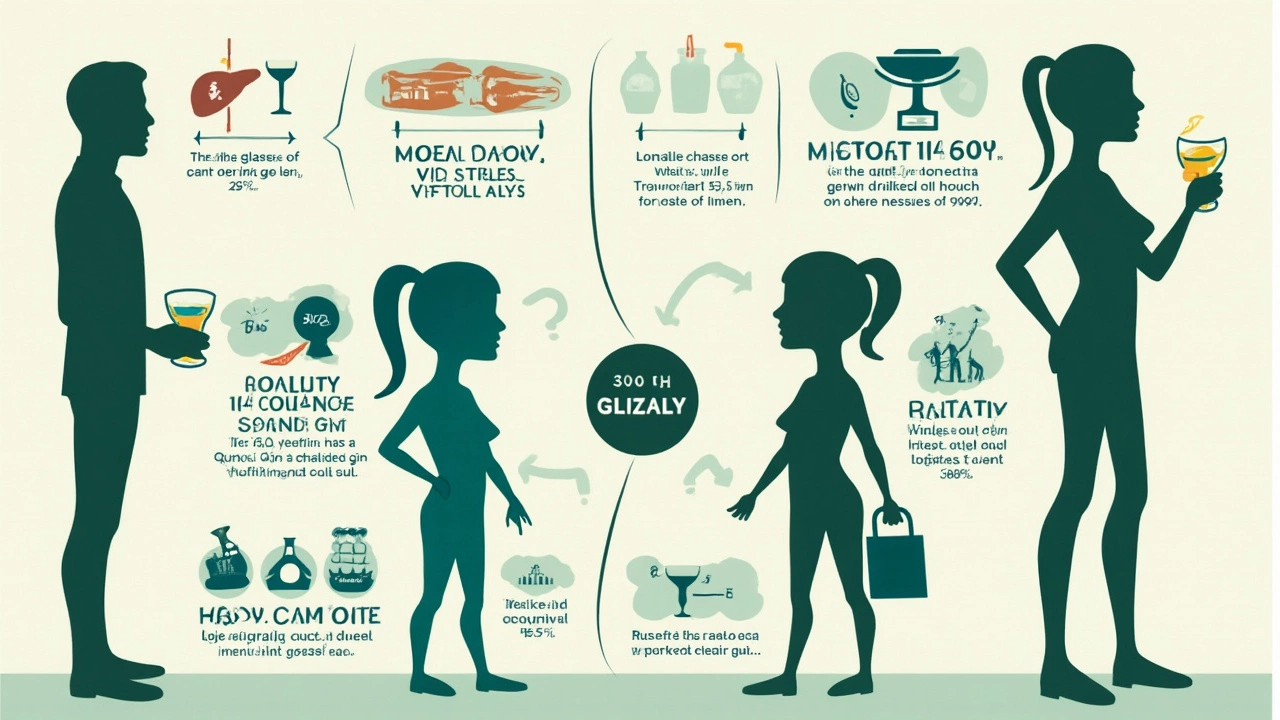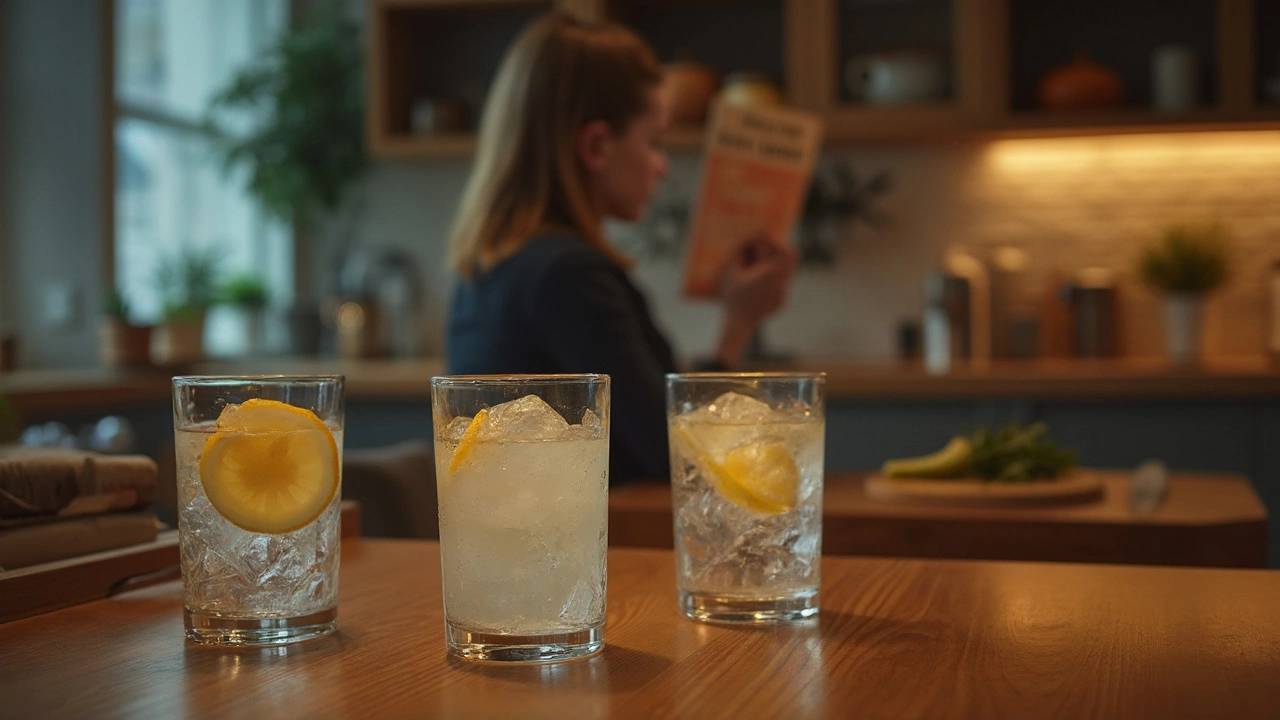Three gins a night sounds harmless. It’s a casual number, like hitting snooze one extra time or eating dessert after dinner. A lot of people don’t give it a second thought, especially after a hectic day or during an easy night out. But is it actually fine, or is it quietly causing trouble? You might assume the answer only matters for those who already go hard at the bar, but three gins a night lands right in that grey zone—just enough to make you wonder if it’s cool or a little too much.
What Counts as a Standard Gin and Why It Matters
Let’s get specific—one standard gin drink isn’t always what gets poured. The classic “measure” is 1.5 ounces (about 44 ml) of 40% alcohol gin, served neat, on the rocks, or tossed into tonic. You might think, "My bartender gives me a bit more," or maybe your home glassware turns three drinks into the equivalent of five. It matters because all the health data connecting drinking to risk and recommendations is based on these standard pours, not your best guess.
Now, if you’re pouring your own, track the actual measure—many folks unintentionally overpour by as much as 50%. A quick fact: A UK national survey in 2022 showed home drinkers usually pour 1.6 to 1.9 times a standard unit per glass. So, three casual gins could equal up to five-and-a-half standard drinks—no joke.
The US CDC defines “moderate drinking” for men as two or fewer drinks per day, and for women, it’s one. That’s not just for the sake of being a buzzkill; it’s linked to lower rates of heart disease, cancer, and other health headaches. So, when you hear “three gins,” know that most agencies and doctors mean three standard pours—no more.
Here’s a quick breakdown in a table:
| Drink | Ounces (ml) | Alcohol Content (%) | Alcohol Units |
|---|---|---|---|
| Typical Bar Gin | 1.5 (44) | 40 | 1 unit |
| Home-Poured Gin (avg.) | 2.5 (74) | 40 | 1.6-1.9 units |
The issue isn’t just how much you think you’re drinking; it’s what you’re actually pouring into your glass, night after night.
How Three Gins Nightly Hits Your Body
So what happens inside when three gins become a nightly habit? First, let’s run through some *real* stuff. The liver takes the brunt, working overtime to break down the alcohol. Regular drinkers—even at 3 gins a night—see risk factors go up. According to a major 2023 meta-study in The Lancet, drinking over two standard drinks daily raised the likelihood of fatty liver, high blood pressure, and certain cancers by 25-40% compared to those who didn’t drink, or drank less.
But there’s more to it than scary stats. Let’s talk mood and sleep—the everyday stuff you might notice. Gin is no different from other spirits when it comes to the brain: it relaxes at first, but over time, it can increase anxiety, lower your REM sleep, and make you tired the next day. Even people who believe alcohol “helps them unwind” often don’t realize the after-effect: you fall asleep faster, but your body’s sleep is lighter and less restorative. Been waking feeling groggy after a few gins? That’s the biochemical hangover most don’t link directly to moderate drinking.
Your digestive system gets a hit, too. Three gins might not wreck your stomach in one go, but night after night? It can up your risk for gastritis and acid reflux. And if you also pair your gin with rich snacks, that’s another hit to your body’s balance.
Plus, tolerance sneaks up. You get used to the buzz, so it doesn’t feel as strong, but your organs are working just as hard. People drinking three gins a night often report not “feeling it” after a while and raising their intake. This is where it starts to slide quietly into risky territory without warning lights going off.

How Three Gins a Night Shapes Your Habits and Mindset
Let’s talk routine. Habits form fast, and pouring a gin becomes second nature. You’re not always reaching for a drink because you’re stressed or celebrating—sometimes it’s just clockwork. Recent behavioral studies say it only takes around 66 days for a repeated evening drink to become automatic for most people. The kicker: most drinkers don’t consider themselves “heavy” unless things have clearly spiraled.
That feeling of “it’s only a little” is strangely common. Social media doesn’t help. Gin has developed a reputation as the hip, sophisticated drink. You’ll see recipe videos and posts celebrating “gin o’clock,” normalizing daily consumption. What’s rarely shown is someone going dry for a month and the actual energy spike and clearer skin they get. Want to get real? There’s a reason “Sober October” and “Dry January” keep gaining steam—lots of people quietly feel better when nightly drinks go out the window, even if they never considered themselves problem drinkers.
Then there’s money. Drinking at home is cheaper than the bar, but three gins a night still adds up. Do the math: if your favorite mid-shelf gin runs $25 a bottle and you pour two bottles a month, that’s $600 a year—before mixers, garnishes, or an impulse upgrade to craft brands. Not life-ruining, but far from pocket change.
If you start looking closer, maybe with a drink tracker app, it might surprise you how quick those numbers stack up. People trying this, according to research published in the journal Alcohol and Alcoholism, actually cut intake just by tracking, not even by resolving to change.
Social Scenes, Stigma, and Pressure: Why We Normalize Three Gins
Here’s the wild part: if you ask your friends, “Is three gins a night too much?”, most won’t flinch. Drinking culture is everywhere. Gin especially holds this strange spot—seen as both classic and modern, sophisticated yet laid-back. You can order a G&T at a wedding or sip it at home after mowing the lawn, and no one bats an eye.
The UK, for example, lists about 42% of adults as "regular drinkers"—more than once a week. But that label is fuzzy. Most regular drinkers don’t think they fall into problem zones if work is steady, relationships are fine, and mornings aren’t full of regret. The truth is, social circles and environments set the tone for what feels “normal.” Try skipping a round on Friday, and you’ll realize just how much pressure hovers around group drinking.
When was the last time you saw a friend call out “just water for me” without an eyebrow raise from someone? Peer habits rub off, too. If your crew does three drinks, you probably will, too. That isn’t just anecdotal—university sociologists have shown drinking rates in friendship groups tend to match up, even adjusting for age or background.
Ever heard someone say, “It’s been a long week—I deserve it”? That’s a tiny story we tell ourselves, turning alcohol into a form of self-care. Is it always harmful? No. But add up years upon years of “I deserve it,” and suddenly you’ve got decades of habits that aren’t serving you. People rarely stop alcohol for health scares; they usually change when their social cues shift. Think about how the pandemic nudged drinking up for some, down for others—context drives choices.

How to Rethink Your Gin Habits (Even If You’re Not Ready to Quit)
So you’re staring at the bottle, asking if three a night is too much. The answer is rarely a hard line—it’s about where you want your health, energy, sleep, and money to go.
First, get honest. Start by tracking—not guessing—your pours for a week. Use a measuring jigger or a small shot glass, and log each one, even if you “top up” the glass. This isn’t a shame session; it’s data-gathering. Once you spot your real intake, see if it lines up with safe-drinking guidance.
Next, try swapping in alcohol-free alternatives now and then. The latest 2025 research shows the non-alcoholic spirits market is booming, with taste and ritual (not just the buzz) driving choices. Grab something botanical, pour over ice, add tonic—keep the ritual, lose the alcohol for a night or two a week. Most people find just one or two swap-outs a week bumps their energy noticeably in a month.
If you’re using gin as a stress reliever, don’t just bulldoze your habit—trade up for a better one. Replace that pre-dinner pour once or twice a week with a walk, podcast, or making an epic snack instead. Not glamorous, but far more doable than dropping straight to zero.
Anyone can use extra support. Set up “dry” nights with a friend, or put your savings toward a trip or hobby—see if competing with yourself or someone else adds motivation. The trick isn’t to shame yourself, but to stay in charge of your choices, not let habit autopilot run the show.
Last tip: Give your body a weekend-without. Two days (back to back) of no alcohol each week gives your liver and metabolism breathing room. This is actually part of the health advice in places like the UK, where “drink-free days” are officially pushed by NHS guidelines for regular drinkers wanting to stay healthy without total abstinence.
Life comes with enough hard lines. When it comes to gin, the real win is being fully in the driver’s seat—knowing exactly what three nightly gins mean for you, and being able to say yes, no, or just one, on your own terms.


